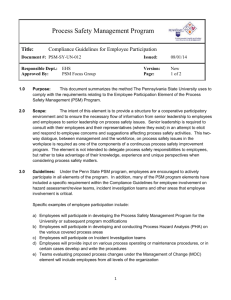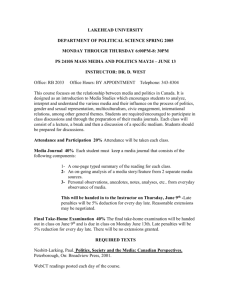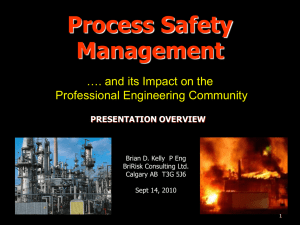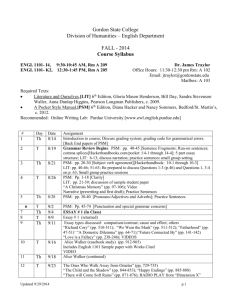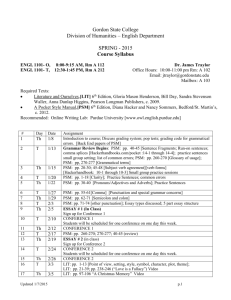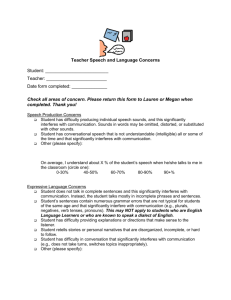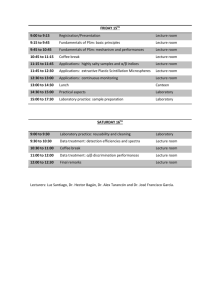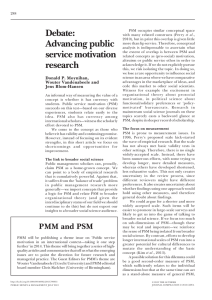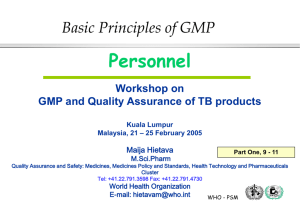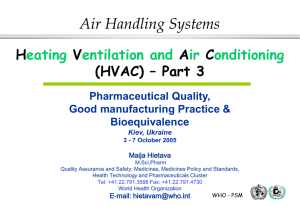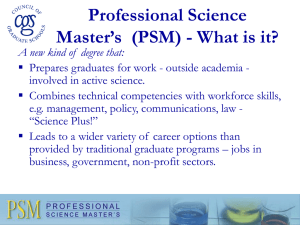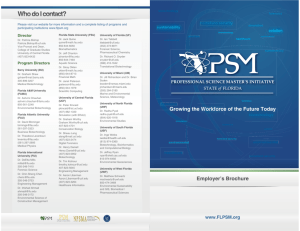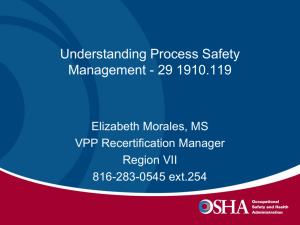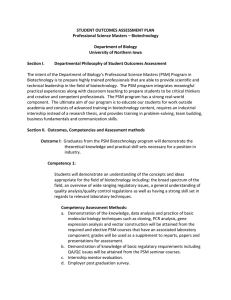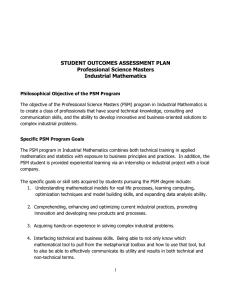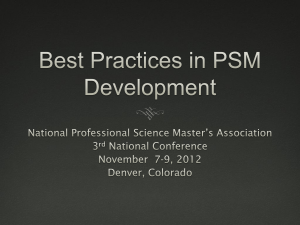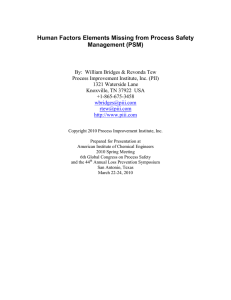Speech & Language Concern Checklist
advertisement
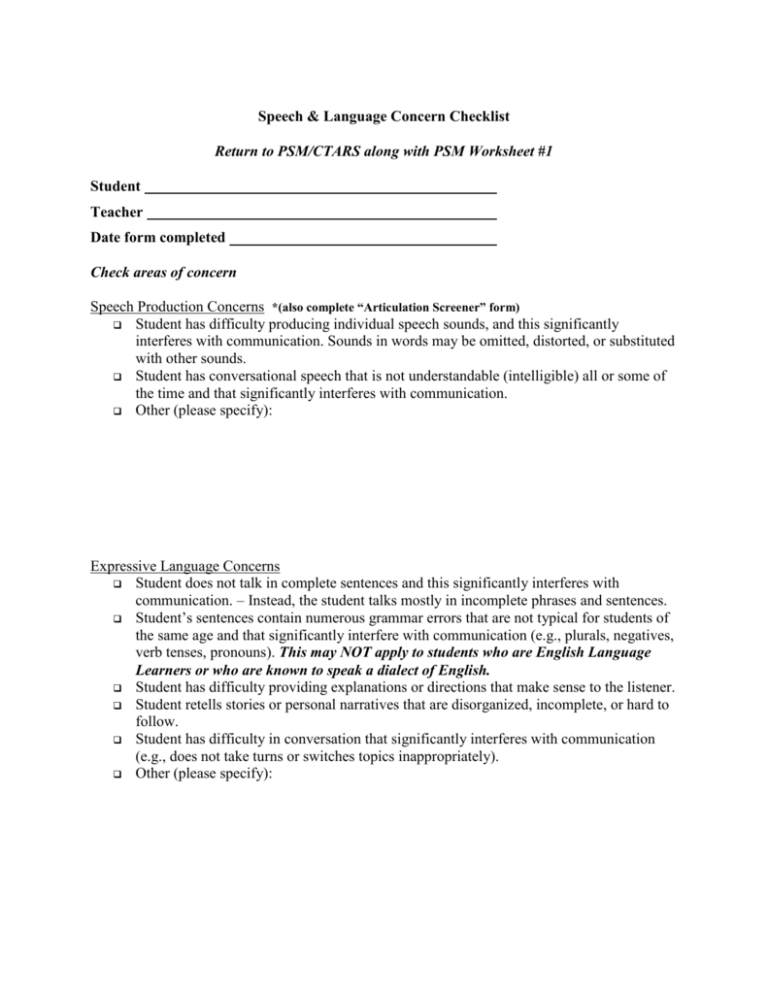
Speech & Language Concern Checklist Return to PSM/CTARS along with PSM Worksheet #1 Student Teacher Date form completed Check areas of concern Speech Production Concerns *(also complete “Articulation Screener” form) Student has difficulty producing individual speech sounds, and this significantly interferes with communication. Sounds in words may be omitted, distorted, or substituted with other sounds. Student has conversational speech that is not understandable (intelligible) all or some of the time and that significantly interferes with communication. Other (please specify): Expressive Language Concerns Student does not talk in complete sentences and this significantly interferes with communication. – Instead, the student talks mostly in incomplete phrases and sentences. Student’s sentences contain numerous grammar errors that are not typical for students of the same age and that significantly interfere with communication (e.g., plurals, negatives, verb tenses, pronouns). This may NOT apply to students who are English Language Learners or who are known to speak a dialect of English. Student has difficulty providing explanations or directions that make sense to the listener. Student retells stories or personal narratives that are disorganized, incomplete, or hard to follow. Student has difficulty in conversation that significantly interferes with communication (e.g., does not take turns or switches topics inappropriately). Other (please specify): Receptive Language/Comprehension Concerns Student does not appear to understand/follow an age-appropriate direction that contains multiple parts. Student does not appear to understand teacher questions presented in class that are ageappropriate. Student does not appear to understand vocabulary words used in class that are at the student’s independent/instructional reading level. Student does not request clarification when it appears the student does not understand a teacher’s verbal direction. Student does not appear to understand comprehension questions about a short story that is at the student’s independent/instructional reading level. Other (please specify): Speech Fluency Concerns Student’s speech contains disfluencies that significantly interfere with communication. Sound, syllable, or word repetitions with obvious tension in face or neck muscles Sound prolongations Blocks (no sound or airflow) Student appears frustrated or upset about his/her dysfluent speech pattern. Other (please specify): Voice Quality Concerns Student’s voice quality significantly interferes with communication Harsh or hoarse voice quality No voice Excessively nasal voice quality Other (please specify): Articulation Screener Return to PSM/CTARS with PSM Worksheet # and Speech-Language Concern Checklist A. Teacher says: Student says: (write response phonetically) 1. boats 2. fork 3. glasses 4. gum 5. leaf 6. nose 7. rock 8. soap 9. spoon 10. star 11. watch 12. chip 13. zipper 14. block 15. grade 16. fruit B. On average, I understand about X % of the student’s speech when he/she talks to me in the classroom: 0-30% 40-50% 60-70% 80-90% Speech-Language Classroom Intervention Plan Complete at initial and follow-up PSM/CTARS team meetings Student Teacher Intervention Start Date Desired Outcomes/Goals (relate to specific speech-language behaviors/concerns identified on PSM worksheet #1 and Speech-Language Concern checklist): Planned Classroom Interventions (List and prioritize): -----------------------------------------------------------------Intervention Completion Date Results of Interventions/Follow-up: Prereferral Documentation for Language, Voice, Fluency Concerns Use a separate form for each intervention – 2 interventions are required Student: Intervention Start Date: Teacher: Intervention: Teacher Support: Student response: 1 – no change FS – full support Week 1 Monday 2 Tuesday PS – partial support 3 – some positive change Wednesday Thursday 4 MS – minimal support 5 – good positive change Friday Teacher Support Student Response Week 2 Teacher Support Student Response Week 3 Teacher Support Student Response Week 4 Teacher Support Student Response Week 5 Teacher Support Student Response Week 6 Teacher Support Student Response Return this sheet to PSM/CTARS Team at follow-up meeting. Comments Prereferral Documentation for Articulation Concerns Use a separate form for each intervention – 2 interventions are required Student: Intervention Start Date: Teacher: Intervention: Stimulus: Student response: Week 1 I – sound in isolation 1 – unable to produce sound Monday Tuesday SS – sound in syllable SN – sound in sentence 2 – inconsistently produces sound 3 – easily produces sound Wednesday Thursday Friday Comments Stimulus Student Response Week 2 Stimulus Student Response Week 3 Stimulus Student Response Week 4 Stimulus Student Response Week 5 Stimulus Student Response Week 6 Stimulus Student Response Note: It is recommended that the sound be targeted in isolation for weeks 1 and 2, targeted in syllables for weeks 3 and 4, and targeted in sentences for weeks 5 and 6. Return this sheet to PSM/CTARS Team at follow-up meeting.
